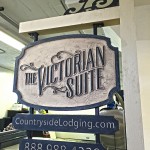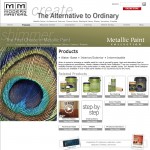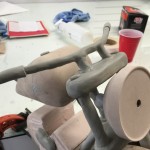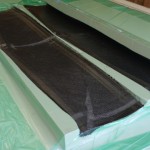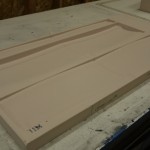Today we delivered this little beauty. On this project we had a chance to weld, carve, paint, glaze, and fabricate wood posts. It’s fun to look back and see how far we have come in both the machinery dept. and in our overall capabilities
Synergy Sign and Graphics Blog
Special Thanks to all of our new Partners and Sponsors.
We signed on with another Partner today. Modern Masters has been gracious enough to supply us all of the paints for our upcoming gear projects. We will be building 2 gears for Multicam and 1 gear for Coastal Enterprises . All three gears will be getting painted with Modern Masters Metallics and reactive paints. Modern Masters will also be featuring us in their ad materials throughout the coming year, so keep an eye out for us! We would like to send out a formal thanks to Robert and Denis @ Multicam, Greg @ Modern Masters, and Kellie @ Coastal Enterprises for acknowledging our work and helping us raise the bar in the sign industry
KC’s Car Care – Redux – ( and some big news )
From time to time, we may miss the mark a little. In this case, we had an idea that the car and bike should be the same scale. Once the bike was applied, the customer didn’t like the size of it.
It’s Raining Software!
Well after a long blog hiatus, I’m back and happy to report there are some exciting things happening in the land of CAD. In the past few weeks there has been some very exciting news on the software front. First, out of left field, Autodesk suddenly announced it was going to resume development of T-Splines for Rhino! The first news of this came from the T-Splines message board, where none other than Autodesk CEO Carl Bass chimed in and informed the community of the decision. That pretty much made my jaw drop to the floor. This means that there will be future releases of T-Splines for Rhino, with new tools and functionality. Really, I truly did not see that coming. Also, in the past few days they put out a release candidate for Rhino V5. You can download that here. There are some really nice fixes and upgrades in that release – most notably for symmetry and exact insertion of geometry.
T-Splines Webinar: Transitioning from NURBS to T-Splines
Well let’s get some of the dust off this blog, it’s been far too long. I’ve been busy with a variety of projects and distractions, unfortunately very little of which can be shared here. I did however do a nice one hour webinar hosted by Autodesk on the very basics of T-Splines. Especially for those who are coming from a NURBS surface modeling background (as I did), T-Splines can be a fairly daunting piece of software to wrap your head around. The way you work in T-Splines is often very different from your standard workflow where you start with your big macro shapes, and then trim them and blend them together. So, with that in mind, we created what will be the first in a series of webinars aimed at helping people make the conceptual leap. At the end of the webinar there is a preview of T-Splines running on an Autodesk platform, which is very exciting to see, since there has not been a ton of information forthcoming about how T-Splines will be integrated into Autodesk products. The folks at Autodesk took the “Egg Man” demo I did at the end of the presentation and put it to some music, which I thought was really cool. So, dim the lights, crank the speakers, and enjoy!
48″ Convair 240 – Wing Lofting
Pecking away at the Convair 240 radio control model. This is being done for a contest on the Ezone forums , and so I really need to get moving on this thing to get it in the air by June 30th contest end date. The wings are getting there – mostly lofted, just have to add the rear spars and ailerons. Having designed more than my fair share of RC planes in 2D using AutoCAD, boy, is this a better way to work! The wings are going to be my favorite style – 1/32″ balsa d-tube leading edges with shear webs. Super strong, super light, and very “stick and tissue.” I’m going to try to get the tailfeathers and fuselage formers knocked out this weekend. Haven’t quite decided if I want to do the nacelles out of balsa or vac formed styrene, but I’ll have to make a call on that pretty soon.
Using Rare Earth Magnets to Join Composite Structures
You know what I think is a little silly? Using clecoes to join composite structures. I mean, sure, they work, but unlike when you are working with sheet metal, at the end of it you have a bunch of useless holes that have to get filled in. Also, multiple insertions/removals of the cleco tends to open up the hole, reducing the grip of the cleco. So I started thinking about a better way of doing it, and I think I’ve come up with a workable solution – rare earth magnets. I’ve used them on radio controlled aircraft in the past, and have always been amazed by their small size and large holding power. So, I bought some of these 5/16″X3/16″ N42 disc magnets from K&J Magnetics . On the inside of joggle for the Giles 200 gear leg fairings I put down some electrical tape. I then placed a disc magnet every 1.5″ along the length of the joggle. The fairing half is on a magnetic building board that I use for building balsa model airplanes, this was very handy because it kept all the magnets in place while I laid them out. Tucker and Walnut, faithful four legged shop assistants supervise from below: Okay, really, they’re just watching for that cat that walks by the window from time to time. Anyhow, moving on – I then broke out the hot glue gun, and just surrounded each magnet with a little glue. All we’re going for here is keeping them from falling off the tape once we slide this thing off the table. Then, I simply clamped the two halves together at the edges. After that, I just took one magnet at a time, placed it relatively close to where I thoughts a magnet was. Once I felt it pull, I just let go, and the magnet snapped into place. Well that was easy! The “hole layout” was less time consuming than if I was using drills/clecos, and more tolerant of edge distance. Once I bond these together and the resin has cured I’ll simply slide the exterior magnets off one by one, and then pull off the piece of electrical tape that the interior magnets are glued to. Easy! Obviously, this will only work in non-blind applications, but it sure seems like a nice method to me. If your alignment is super critical, I would still recommend using a few holes/clecoes just to make indexing them together fool proof
The Method Part II – Demolding the Parts
Following up on my previous post on my method of making high quality, re-usable tooling with CNC machined foam and Stretchelon bagging film , here’s how things tend to go on the demold side. First, turn off the pumps, and then remove all the secondary fabrics/films that are bagging the part: I’ve left the peel ply on here, because the parts are still pretty darn soft, but everything else has gone into the trash. Now, simply get some air underneath the layer of Stretchelon covering the mold, and then pull the parts up, along with the film: Now, just simply peel the Stretchelon off the parts – if you’ve used mold release, it should come off very easily more or less in one piece: Presto! And the molds are totally unharmed – same as they were when we started. Here’s a closeup of the surface texture of the finished part: Yes, a bit of texture, but like I said before, a few swipes with some 80 grit to prepare for primer and the texture just vanishes. Or, if you really want a smoother texture, just get more dense tooling foam.
Creating High Quality, Reusable Molds with CNC Machined Foam and Stretchelon Bagging Film – aka “The Method”
This post is really the culmination of a few years of research, research that I’ve decided to set loose into the world. We call this “The Method,” or sometimes “The Stretchelon Trick” and it’s my primary method of creating tooling for composite parts these days. As an example, I’m using the Giles 200 gear leg fairings that I describe in depth in this post here. You might read that post and think “well that’s all well and good, but what the heck are you going to make those molds out of that’s cost effective?” The answer is medium density polyurethane tooling foam, normally 15 lb. density foam. For these gear legs, the depth of the mold is about 1.5″, so I used 2″ thick foam. A 2″X48″X96″ block of tooling foam is about $500, and this particular mold is about 23″X40″, so the material cost is a fairly small fraction of that. Here’s the machined foam of the gear leg fairings, cut yesterday: Okay, granted, it’s a bit hard with the light here to really see what’s going on, but if you look at the post I link to above, you’ll see this is just the CNC machined version of the gear leg tooling. Since one of these molds is two part, the next step is to join the two parts together: We usually join them together with some fast setting epoxy and then drive some dowels into them for good measure. Now at this point you’re probably thinking “well that’s nice and all, but now you’ve gotta spray some sort of primer/sealer onto that thing, and hand finish it.” But, you would be wrong. You see, I hate sanding. Actually, that’s not really true, I like doing body work, but I hate sanding when there’s no point to it. And now let me show you why there’s no point to it: This, my friends, is the heart of “The Method.” The green stuff over the mold is an elastic vacuum bagging material called Stretchelon . Stretchelon is a high elongation vacuum bagging film. I hate dealing with bagging tape, and so I’ve routered channels into my work table here, coated them with shelf paper and then used hardware store screen door spline to create the seal. This method works quite well, but you can just as easily make a tube out of the Stretchelon and put the mold in the tube. I pull my vacuum for the mold from the bottom of the table. The mold is sitting on a piece of breather so that the air gets evacuated from all around the mold. The slight porosity of the foam does wonders to allow the air to travel to the edge of the foam. Closeup, it’s looks like this: The Stretchelon pulls down right onto the foam, sealing it for use. Pretty cool huh? Yes, there is a bit of a texture to the mold. If you want a smoother mold, just buy higher density foam. But what I’ve found is that since the first thing I do when I go to prime a part is to scuff it up, that texture simply vanishes with a few strokes of a sanding block. The final thing to do is put some mold release on it – the film is polyurethane and so epoxy will stick to it. I’ve used Frekote in the past, but I like to use another Airtech product called Safelease 20L . It can be dispensed from one of those hand squeeze spray bottles you get at the hardware store, so I like the fact I’m not using a bunch of aerosol cans. And it works, so that’s nice. Anyhow, once you spray your mold down with some release and then wipe off the excess, this mold is pretty much like any other – yes, it’s slightly more ding prone than standard hard tooling. If you want to make lots of parts (let’s say, more than 10) then I would simply go with a more dense foam, say 25 lbs. If you get any dings, you can simply patch them with spackle. When I first starting doing this, I was really concerned about mold wear, but frankly it just hasn’t been a real problem. Some of my molds have been used 10-12 times now, and for the most part they look just like they did the first time. So now, it’s just a matter of laying up the laminate, in this case 3 layers of 5.7 oz carbon: And then, you vacuum bag another layer of Stretchelon (or regular bagging film) over on top of the part: Your standard peel ply/perf/breather fabrics are on top of the carbon. The vacuum for the top bag comes from a standard bag tap. So we’ve got two separate pumps running here – one for the mold, and one for the part. They’re both around 25-26″ of mercury. You’ll get a few more inches of mercury with a bag tube made with bagging tape, but the cost and labor savings of this whole screen spline method are nice
